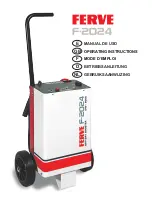
9.9 Performance: You will notice that your engine
runs stronger on cold days than on very hot ones.
This is due to the nature of the internal combustion
engine. When the air is cold, the engine receives a
denser charge of air, thus more power can be pro-
duced. While this is true with any engine, the
supercharger amplifies this cold air benefit.
10.0 LONG TERM MAINTENANCE
10.1 BELTS
The only item to watch with your supercharger kit
will be the belt tension for the supercharger drive.
If you have a tension gauge for a poly-vee belt, the
tension is to be 90 pounds. If you see a large
accumulation of belt dust on your supercharger, it
is an indication that your belt is slipping. A slight
amount of belt dust is normal. CHECKING YOUR
BELT FOR WEAR: As the belt wears, small cracks
will form in each of the ribs on the inside run of the
belt. Replace your belt when you can count six
cracks within in one inch of length (six cracks total
from all ribs combined).
10.2 DRIVEABILITY
If you notice a driveabilty problem as your car
ages, have your fuel pressure checked. Have a
technician install an accurate 0 to100psi fuel
pressure gauge in the fuel line BEFORE it enters
the fuel rail .
10.3 Every six months or so, check your hose
clamps for correct tension. The rubber hoses will
take a set and the clamps may not be holding as
tight. Also check all mounting bolts and nuts, par-
ticularly the throttle cable anchor bracket.
10.4 Your air filter is a long-life unit needing serv-
ice only every 15,000 miles. To clean, you can
wash the filter element in soap and water. Use a
dish detergent soap such as Dawn, etc. Rinse
thoroughly and allow to dry. Wet the filter element
with a light application of ATF (automatic trans-
mission fluid). Alternatively, a special cleaning kit
is available from Jackson Racing (#901-970).
10.5 At every oil change, lubricate the bypass
actuator arm contact point and shaft bushing with
light grease to insure long life - these parts are
exposed to under hood dirt and grime.
TROUBLESHOOTING
SYMPTOM: Engine cranks but will not start
PROBABLE CAUSES: Airflow meter disconnect-
ed; Idle air line open; Low battery voltage
CURE: Double check that seven pin to airflow
meter is well connected. Re-check the 3/4” ICS
line and the PCV line to see that they are not
leaking. Use a known good battery to “jump” the
Miata’s battery. It is possible to have enough volt-
age to crank a Miata but not enough to correctly
run the engine’s control computer.
SYMPTOM: Unstable Idle
PROBABLE CAUSE: Idle air screw set incorrect-
ly; Restrictor left out in step #7.8; Pinched idle air
balance line; air leak in intake track.
CURE: Re-check restrictor. Check idle adjustment
procedure in step 8.1 above. Check the idle air
balance line for restriction or pinching. Check for
air leaks - vacuum at idle should be at least 17.7
in Hg.
11.0 FURTHER MODIFICATIONS
Now that your Miata has a stronger engine, there
are a few changes you might want to make to the
rest of the car to improve its performance. A free
flowing exhaust system will make your super-
charged Miata that much faster.
Options include a 4-2-1 header (#903-110, CARB
approved, Manual Transmission only) and a cat-
back exhaust system. Both are available at
MiataMania.com & Supercharger.com. Also, while
your new supercharger and the standard Mazda
clutch work well together, it is a good idea to step
up to the ACT Stage 1 clutch kit (#999-606) when
you change your clutch.
WARRANTY: The supercharger system carries a
two-year or 100,000 mile warranty (for the original
purchaser of the kit) against defects in materials
and workmanship. No other warranties apply. This
warranty is void if the subject vehicle is used in
any racing activities of any sort.
HELP: If you experience any problems with your
kit during installation or operation, contact your
retailer or Jackson Racing at 1-888-888-4079.
Supercharger Installation Instructions
999-156, 999-157, 999-158 & 999-159
-16-
Revised 06/08


































